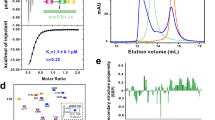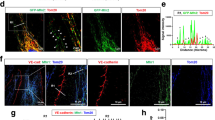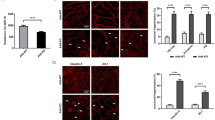Abstract
Adherens junctions (AJs) and tight junctions (TJs) comprise a junctional complex which plays key roles not only in cell adhesion and polarization but also in regulation of cell movement and proliferation in epithelial cells. E-Cadherin and nectin are major cell–cell adhesion molecules (CAMs) at AJs, whereas claudin is a major CAM at TJs. We have shown that the cadherin-based cell–cell adhesion is not formed in MDCK cells in which annexin II, a Ca2+- and phospholipid-binding protein, is knocked down. Here, we found that TJs and the nectin-based cell–cell adhesions were formed in annexin II-knockdown cells. The formation of TJs in annexin II-knockdown MDCK cells required the nectin-based cell–cell adhesion and afadin, a nectin- and actin-filament-binding protein. In addition, it required the activation of Cdc42 and Rac small G proteins and subsequent reorganization of the IQGAP1-dependent actin cytoskeleton which were induced by the nectin-based cell–cell adhesion. These results indicate that the nectin-based cell–cell adhesion and afadin, but not the cadherin-based cell–cell adhesion, are necessary for the formation of TJs and that the signaling by nectin and the subsequent reorganization of the actin cytoskeleton are also necessary for the formation of TJs under certain conditions.
This is a preview of subscription content, access via your institution
Access options
Subscribe to this journal
Receive 50 print issues and online access
$259.00 per year
only $5.18 per issue
Buy this article
- Purchase on Springer Link
- Instant access to full article PDF
Prices may be subject to local taxes which are calculated during checkout










Similar content being viewed by others
References
Abercrombie M, Heaysman JE . (1953). Exp Cell Res 5: 111–131.
Adams CL, Nelson WJ . (1998). Curr Opin Cell Biol 10: 572–577.
Andreeva AY, Krause E, Muller EC, Blasig IE, Utepbergenov DI . (2001). J Biol Chem 276: 38480–38486.
Balda MS, Gonzalez-Mariscal L, Matter K, Cereijido M, Anderson JM . (1993). J Cell Biol 123: 293–302.
Cavallaro U, Christofori G . (2004). Nat Rev Cancer 4: 118–132.
Dejana E . (2004). Nat Rev Mol Cell Biol 5: 261–270.
Farquhar MG, Palade GE . (1963). J Cell Biol 17: 375–412.
Fisher HW, Yeh J . (1967). Science 155: 581–582.
Fukuhara A, Irie K, Nakanishi H, Takekuni K, Kawakatsu T, Ikeda W et al. (2002a). Oncogene 21: 7642–7655.
Fukuhara A, Irie K, Yamada A, Katata T, Honda T, Shimizu K et al. (2002b). Genes Cells 7: 1059–1072.
Fukuhara T, Shimizu K, Kawakatsu T, Fukuyama T, Minami Y, Honda T et al. (2004). J Cell Biol 166: 393–405.
Fukuyama T, Ogita H, Kawakatsu T, Fukuhara T, Yamada T, Sato T et al. (2005). J Biol Chem 280: 815–825.
Garrod DR, Merritt AJ, Nie Z . (2002). Curr Opin Cell Biol 14: 537–545.
Gerke V, Moss SE . (2002). Physiol Rev 82: 331–371.
Getsios S, Huen AC, Green KJ . (2004). Nat Rev Mol Cell Biol 5: 271–281.
Gonzalez-Mariscal L, Chavez de Ramirez B, Cereijido M . (1985). J Membr Biol 86: 113–125.
Gumbiner B, Stevenson B, Grimaldi A . (1988). J Cell Biol 107: 1575–1587.
Gumbiner BM . (2000). J Cell Biol 148: 399–404.
Harris TJ, Peifer M . (2004). J Cell Biol 167: 135–147.
He TC, Zhou S, da Costa LT, Yu J, Kinzler KW, Vogelstein B . (1998). Proc Natl Acad Sci USA 95: 2509–2514.
Honda T, Shimizu K, Fukuhara A, Irie K, Takai Y . (2003a). Biochem Biophys Res Commun 306: 104–109.
Honda T, Shimizu K, Kawakatsu T, Yasumi M, Shingai T, Fukuhara A et al. (2003b). Genes Cells 8: 51–63.
Hoshino T, Sakisaka T, Baba T, Yamada T, Kimura T, Takai Y . (2005). J Biol Chem 280: 24095–24103.
Inoue O, Suzuki-Inoue K, Dean WL, Frampton J, Watson SP . (2003). J Cell Biol 160: 769–780.
Itoh M, Nagafuchi A, Moroi S, Tsukita S . (1997). J Cell Biol 138: 181–192.
Itoh M, Sasaki H, Furuse M, Ozaki H, Kita T, Tsukita S . (2001). J Cell Biol 154: 491–497.
Izumi G, Sakisaka T, Baba T, Tanaka S, Morimoto K, Takai Y . (2004). J Cell Biol 166: 237–248.
Katata T, Irie K, Fukuhara A, Kawakatsu T, Yamada A, Shimizu K et al. (2003). Oncogene 22: 2097–2109.
Kawakatsu T, Ogita H, Fukuhara T, Fukuyama T, Minami Y, Shimizu K et al. (2005). J Biol Chem 280: 4940–4947.
Kawakatsu T, Shimizu K, Honda T, Fukuhara T, Hoshino T, Takai Y . (2002). J Biol Chem 277: 50749–50755.
Kuroda S, Fukata M, Kobayashi K, Nakafuku M, Nomura N, Iwamatsu A et al. (1996). J Biol Chem 271: 23363–23367.
Ma TY, Hoa NT, Tran DD, Bui V, Pedram A, Mills S et al. (2000). Am J Physiol Gastrointest Liver Physiol 279: G875–G885.
Mandai K, Nakanishi H, Satoh A, Obaishi H, Wada M, Nishioka H et al. (1997). J Cell Biol 139: 517–528.
Miki H, Sasaki T, Takai Y, Takenawa T . (1998). Nature 391: 93–96.
Nagafuchi A . (2001). Curr Opin Cell Biol 13: 600–603.
Nagafuchi A, Ishihara S, Tsukita S . (1994). J Cell Biol 127: 235–245.
Ohno S . (2001). Curr Opin Cell Biol 13: 641–648.
Okamoto R, Irie K, Yamada A, Katata T, Fukuhara A, Takai Y . (2005). Genes Cells 10: 435–445.
Perez-Moreno M, Jamora C, Fuchs E . (2003). Cell 112: 535–548.
Quinlan MP, Hyatt JL . (1999). Cell Growth Differ 10: 839–854.
Roh MH, Margolis B . (2003). Am J Physiol Renal Physiol 285: F377–F387.
Rubinfeld B, Munemitsu S, Clark R, Conroy L, Watt K, Crosier WJ et al (1991). Cell 65: 1033–1042.
Sakisaka T, Takai Y . (2004). Curr Opin Cell Biol 16: 513–521.
Sato T, Fujita N, Yamada A, Ooshio T, Okamoto R, Irie K et al. (2006). J Biol Chem 281: 5288–5299.
Shimizu K, Takai Y . (2003). J Biochem (Tokyo) 134: 631–636.
Sonoda N, Furuse M, Sasaki H, Yonemura S, Katahira J, Horiguchi Y et al. (1999). J Cell Biol 147: 195–204.
Spector I, Shochet NR, Blasberger D, Kashman Y . (1989). Cell Motil Cytoskeleton 13: 127–144.
Stevenson BR, Begg DA . (1994). J Cell Sci 107: 367–375.
Takai Y, Irie K, Shimizu K, Sakisaka T, Ikeda W . (2003). Cancer Sci 94: 655–667.
Takai Y, Nakanishi H . (2003). J Cell Sci 116: 17–27.
Takeichi M . (1995). Curr Opin Cell Biol 7: 619–627.
Takekuni K, Ikeda W, Fujito T, Morimoto K, Takeuchi M, Monden M et al. (2003). J Biol Chem 278: 5497–5500.
Tsukita S, Furuse M . (1999). Trends Cell Biol 9: 268–273.
Tsukita S, Furuse M, Itoh M . (2001). Nat Rev Mol Cell Biol 2: 285–293.
Umeda K, Matsui T, Nakayama M, Furuse K, Sasaki H, Furuse M et al. (2004). J Biol Chem 279: 44785–44794.
van Hengel J, Gohon L, Bruyneel E, Vermeulen S, Cornelissen M, Mareel M et al. (1997). J Cell Biol 137: 1103–1116.
Vasioukhin V, Bauer C, Yin M, Fuchs E . (2000). Cell 100: 209–219.
Watabe M, Nagafuchi A, Tsukita S, Takeichi M . (1994). J Cell Biol 127: 247–256.
Wittchen ES, Haskins J, Stevenson BR . (1999). J Biol Chem 274: 35179–35185.
Wittchen ES, Haskins J, Stevenson BR . (2000). J Cell Biol 151: 825–836.
Yagi T, Takeichi M . (2000). Genes Dev 14: 1169–1180.
Yamada A, Irie K, Fukuhara A, Ooshio T, Takai Y . (2004). Genes Cells 9: 843–855.
Yamada A, Irie K, Hirota T, Ooshio T, Fukuhara A, Takai Y . (2005). J Biol Chem 280: 6016–6027.
Yap AS, Brieher WM, Gumbiner BM . (1997). Annu Rev Cell Dev Biol 13: 119–146.
Yokoyama S, Tachibana K, Nakanishi H, Yamamoto Y, Irie K, Mandai K et al. (2001). Mol Biol Cell 12: 1595–1609.
Acknowledgements
We are grateful to Dr M Takeichi (Center for Developmental Biology, RIKEN, Kobe, Japan) for the anti-E-cadherin mAb, Dr W Birchmeier (Max-Delbruck-Center for Molecular Medicine, Berlin, Germany) for MDCK cells, and Dr H Shibuya (Tokyo Medical and Dental University, Tokyo, Japan) for pBS-H1. The work at the Department of Molecular Biology and Biochemistry, Osaka University Graduate School of Medicine/Faculty of Medicine was supported by grants-in-aid for Scientific Research and for Cancer Research from the Ministry of Education, Culture, Sports, Science, and Technology, Japan (2004, 2005).
Author information
Authors and Affiliations
Corresponding author
Rights and permissions
About this article
Cite this article
Yamada, A., Fujita, N., Sato, T. et al. Requirement of nectin, but not cadherin, for formation of claudin-based tight junctions in annexin II-knockdown MDCK cells. Oncogene 25, 5085–5102 (2006). https://doi.org/10.1038/sj.onc.1209525
Received:
Revised:
Accepted:
Published:
Issue Date:
DOI: https://doi.org/10.1038/sj.onc.1209525
Keywords
This article is cited by
-
Serum nectin-2 and nectin-4 are diagnostic in lung cancer: which is superior?
Wiener klinische Wochenschrift (2019)
-
Nectins and nectin-like molecules: roles in contact inhibition of cell movement and proliferation
Nature Reviews Molecular Cell Biology (2008)



